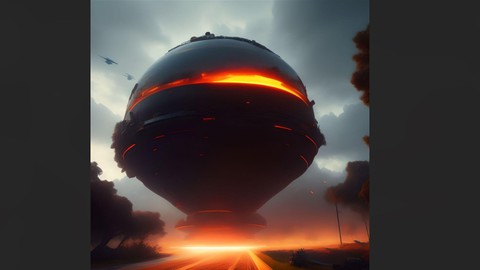
Compositing Essentials with Nuke
Compositing Essentials with Nuke, available at $59.99, has an average rating of 3.95, with 113 lectures, based on 19 reviews, and has 150 subscribers.
You will learn about Understand the basic principles of compositing, including working with alpha channels, color correction and grading, and keying and chroma keying. Develop proficiency in Nuke's node-based workflow, including the ability to create, connect, and manipulate nodes to achieve specific compositing goals. Gain a comprehensive understanding of Nuke's advanced compositing nodes and workflows, such as keying and 3D compositing,. Learn how to troubleshoot common issues that can arise during the compositing process, optimize compositing workflows to increase efficiency. Apply the knowledge and skills learned in the course to a final project, receiving feedback and critiques on the final project, and gaining confidence. This course is ideal for individuals who are Students and professionals It is particularly useful for Students and professionals.
Enroll now: Compositing Essentials with Nuke
Summary
Title: Compositing Essentials with Nuke
Price: $59.99
Average Rating: 3.95
Number of Lectures: 113
Number of Published Lectures: 113
Number of Curriculum Items: 113
Number of Published Curriculum Objects: 113
Original Price: ₹7,900
Quality Status: approved
Status: Live
What You Will Learn
- Understand the basic principles of compositing, including working with alpha channels, color correction and grading, and keying and chroma keying.
- Develop proficiency in Nuke's node-based workflow, including the ability to create, connect, and manipulate nodes to achieve specific compositing goals.
- Gain a comprehensive understanding of Nuke's advanced compositing nodes and workflows, such as keying and 3D compositing,.
- Learn how to troubleshoot common issues that can arise during the compositing process, optimize compositing workflows to increase efficiency.
- Apply the knowledge and skills learned in the course to a final project, receiving feedback and critiques on the final project, and gaining confidence.
Who Should Attend
- Students and professionals
Target Audiences
- Students and professionals
Welcome to “Compositing Essentials with Nuke,” an immersive course designed to equip you with the fundamental skills and knowledge required to excel in the world of digital compositing using the industry-leading software, Nuke. Whether you are a beginner venturing into the exciting realm of visual effects or an intermediate artist seeking to refine your compositing abilities, this course will provide you with a solid foundation to create stunning, seamless visual compositions.
You will dive deep into the principles and techniques of compositing, focusing specifically on Nuke’s robust capabilities. The course will begin with an overview of the compositing process, exploring concepts such as color theory, image manipulation, and visual storytelling. You will gain an understanding of the various elements that make up a composite and how to seamlessly integrate them to achieve realistic and visually compelling results.
As the course progresses, you will learn the intricacies of Nuke’s powerful node-based workflow, enabling you to effectively manipulate and control visual elements. You will become familiar with essential tools and techniques, including keying, rotoscoping, tracking, matte creation, and blending modes. Through hands-on exercises and projects, you will apply these techniques to real-world scenarios, enhancing your practical skills and problem-solving abilities.
Furthermore, the course will explore advanced topics such as 3D integration, camera projections, and the use of CGI elements within composites. You will discover how to integrate CG renders seamlessly into live-action footage, adding depth and realism to your compositions. Additionally, you will explore the creative aspects of compositing, including color grading, lighting effects, and stylization, allowing you to add your artistic touch to every project.
By the end of this course, you will have developed a strong foundation in compositing techniques and a comprehensive understanding of Nuke’s capabilities. You will possess the skills necessary to tackle complex compositing challenges and create visually stunning compositions. Whether your interests lie in film, television, advertising, or gaming, this course will empower you to unleash your creativity and take your compositing skills to the next level using Nuke. Get ready to embark on an exciting journey into the world of visual effects and bring your imagination to life!
Course Curriculum
Chapter 1: Introduction to compositing
Lecture 1: Reading material for What is compositing
Lecture 2: Reading material for History of compositing
Lecture 3: Reading material for Application of Compositing in industry
Lecture 4: Reading material for Role of a compositor in the visual effects industry
Lecture 5: Reading material for Modern day developments in VFX compositing
Lecture 6: Reading material for Future prospects of VFX compositing
Chapter 2: Introduction to Nuke
Lecture 1: Introduction to Nuke
Lecture 2: Introduction to the interface of Nuke Part-1
Lecture 3: Introduction to the interface of Nuke Part-2
Lecture 4: Introduction to the interface of Nuke Part-3
Lecture 5: Introduction to the interface of Nuke Part-4 (Transform Node)
Lecture 6: Introduction to the interface of Nuke Part-5 (Merge Node with Transform Node)
Lecture 7: Introduction to the interface of Nuke Part-6 (Viewer Display)
Lecture 8: Introduction to the interface of Nuke Part-7 (Timeline, Project Settings & Pref)
Lecture 9: Introduction to the interface of Nuke Part-8 (Working with different nodes)
Lecture 10: Reading material for introduction to Nuke interface
Lecture 11: Reading material for Transform nod in Nuke
Lecture 12: Reading material on merge node and transform node
Lecture 13: Reading material on Nuke Viewer Display
Lecture 14: Reading material on interface of Nuke Part-7 (Timeline, Project Settings & Pref)
Chapter 3: Color Correction
Lecture 1: Introduction to color correction nodes
Lecture 2: Use of color correction nodes (Color Corrector node)
Lecture 3: Use of color correction nodes (Grade node & Hue Correct node)
Lecture 4: Use of color correction nodes (Use of scops)
Lecture 5: Color correcting raw footage
Lecture 6: Matching colors of FG & BG
Lecture 7: Reading material Introduction to color correction nodes
Lecture 8: Reading material Introduction to Color Corrector node
Lecture 9: Reading material Introduction to Grade node and Hue Correct node
Lecture 10: Reading material Use of color correction nodes (Use of scops)
Lecture 11: Reading material color correction
Lecture 12: Reading material color grading
Lecture 13: Reading material color correction of raw footage
Lecture 14: Reading material how to color correct raw footage in Nuke
Lecture 15: Reading material different aspects of color correction
Lecture 16: Reading material working with different color spaces
Lecture 17: Reading material describing psychology of color
Lecture 18: Reading material importance of color wheel in color correction
Lecture 19: Reading material How psychology of color create impact in color grading
Lecture 20: Reading material Color matching of foreground and background footages
Lecture 21: Reading material How color grading impact on the mood of a scene in a film
Lecture 22: Reading material Technical aspects of color correction and color grading
Chapter 4: Chroma removal tools and techniques
Lecture 1: Introduction to keying tools
Lecture 2: Using Primatte Keyer
Lecture 3: Using Keylight
Lecture 4: Using IBK Keyer
Lecture 5: Using Ultimatte Keyer
Lecture 6: Use of Keyer Node
Lecture 7: Advanced Keying Part-1
Lecture 8: Advanced Keying Part-2
Lecture 9: Reading material Chroma keying in compositing
Lecture 10: Reading material Process of chroma shoot
Lecture 11: Reading material How to test that chroma shot is ok or not?
Lecture 12: Reading material History of chroma keying
Lecture 13: Reading material Evolution of chroma keying over the years till modern age.
Lecture 14: Reading material Introduction to keying tools in Nuke
Lecture 15: Reading material Keyer node in Nuke
Lecture 16: Reading material Primatte node in Nuke
Lecture 17: Reading material Keylight node in Nuke
Lecture 18: Reading material Using IBK Keyer
Lecture 19: Reading material Using Ultimatte Keyer
Lecture 20: Reading material Advanced Keying procedure
Lecture 21: Reading material Shadow preservation process from green screen footage
Lecture 22: Reading material Hair preservation process from green screen footage
Lecture 23: Reading material Use of hard matte and soft matte in keying
Lecture 24: Reading material Use of spill suppression
Lecture 25: Reading material Using HueCorrect node to perform spill suppression
Lecture 26: Reading material Importance of grain management during chroma removal process
Chapter 5: 3D Compositing in Nuke
Lecture 1: Introduction to 3D in Nuke Part-1
Lecture 2: Introduction to 3D in Nuke Part-2
Lecture 3: 3D Matte Painting Part-1
Lecture 4: 3D Matte Painting Part-2
Lecture 5: Using Camera Projection
Lecture 6: Reading material Introduction to 3D interface of Nuke
Lecture 7: Reading material 3D matte painting in Nuke
Lecture 8: Reading material Camera projection in Nuke
Chapter 6: Tracking in Nuke
Lecture 1: 4 Point Tracking
Lecture 2: Planar Tracker Node
Lecture 3: Introduction to 3D camera tracking Part-1
Lecture 4: Introduction to 3D camera tracking Part-2
Lecture 5: Introduction to 3D camera tracking Part-3
Lecture 6: Lens Distortion Correction
Lecture 7: Use of Write Geo Node
Lecture 8: Use of Write Node to Render Sequence
Lecture 9: Reading material Camera Tracking in Nuke
Lecture 10: Reading material Use of camera tracker node and camera tracking process in Nuke
Lecture 11: Reading material Lens distortion and how to undistort a footage in Nuke
Lecture 12: Reading material Use of WriteGeo node and the process of exporting 3D scene data
Lecture 13: Reading material 2D Tracking
Lecture 14: Reading material 1 Point Tracking
Lecture 15: Reading material 2 Point Tracking
Lecture 16: Reading material 4 Point Tracking
Lecture 17: Reading material Nuke Tracker Node
Lecture 18: Reading material Planar Tracking
Instructors
-
Supratim Mukherjee
Assistant Professor (Animation dept) Chandigarh University
Rating Distribution
- 1 stars: 1 votes
- 2 stars: 1 votes
- 3 stars: 4 votes
- 4 stars: 4 votes
- 5 stars: 9 votes
Frequently Asked Questions
How long do I have access to the course materials?
You can view and review the lecture materials indefinitely, like an on-demand channel.
Can I take my courses with me wherever I go?
Definitely! If you have an internet connection, courses on Udemy are available on any device at any time. If you don’t have an internet connection, some instructors also let their students download course lectures. That’s up to the instructor though, so make sure you get on their good side!
You may also like
- Best Public Speaking Courses to Learn in March 2025
- Best Affiliate Marketing Courses to Learn in March 2025
- Best Email Marketing Courses to Learn in March 2025
- Best Social Media Management Courses to Learn in March 2025
- Best SEO Optimization Courses to Learn in March 2025
- Best Content Creation Courses to Learn in March 2025
- Best Game Development Courses to Learn in March 2025
- Best Software Testing Courses to Learn in March 2025
- Best Big Data Courses to Learn in March 2025
- Best Internet Of Things Courses to Learn in March 2025
- Best Quantum Computing Courses to Learn in March 2025
- Best Cloud Computing Courses to Learn in March 2025
- Best 3d Modeling Courses to Learn in March 2025
- Best Mobile App Development Courses to Learn in March 2025
- Best Graphic Design Courses to Learn in March 2025
- Best Videography Courses to Learn in March 2025
- Best Photography Courses to Learn in March 2025
- Best Language Learning Courses to Learn in March 2025
- Best Product Management Courses to Learn in March 2025
- Best Investing Courses to Learn in March 2025






















